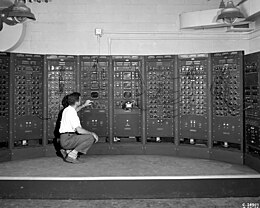Modern era


The Dumaresq was a mechanical calculating device invented around 1902 by Lieutenant John Dumaresq of the Royal Navy. It was an analog computer that related vital variables of the fire control problem to the movement of one's own ship and that of a target ship. It was often used with other devices, such as a Vickers range clock to generate range and deflection data so the gun sights of the ship could be continuously set. A number of versions of the Dumaresq were produced of increasing complexity as development proceeded.
By 1912, Arthur Pollen had developed an electrically driven mechanical analog computer for fire-control systems, based on the differential analyser. It was used by the Imperial Russian Navy in World War I.[15]
Starting in 1929, AC network analyzers were constructed to solve calculation problems related to electrical power systems that were too large to solve with numerical methods at the time.[16] These were essentially scale models of the electrical properties of the full-size system. Since network analyzers could handle problems too large for analytic methods or hand computation, they were also used to solve problems in nuclear physics and in the design of structures. More than 50 large network analyzers were built by the end of the 1950s.
World War II era gun directors, gun data computers, and bomb sights used mechanical analog computers. In 1942 Helmut Hölzer built a fully electronic analog computer at Peenemünde Army Research Center[17][18][19] as an embedded control system (mixing device) to calculate V-2 rocket trajectories from the accelerations and orientations (measured by gyroscopes) and to stabilize and guide the missile.[20][21] Mechanical analog computers were very important in gun fire control in World War II, the Korean War and well past the Vietnam War; they were made in significant numbers.
In the period 1930–1945 in the Netherlands, Johan van Veen developed an analogue computer to calculate and predict tidal currents when the geometry of the channels are changed. Around 1950, this idea was developed into the Deltar, a hydraulic analogy computer supporting the closure of estuaries in the southwest of the Netherlands (the Delta Works).
The FERMIAC was an analog computer invented by physicist Enrico Fermi in 1947 to aid in his studies of neutron transport.[22] Project Cyclone was an analog computer developed by Reeves in 1950 for the analysis and design of dynamic systems.[23] Project Typhoon was an analog computer developed by RCA in 1952. It consisted of over 4,000 electron tubes and used 100 dials and 6,000 plug-in connectors to program.[24] The MONIAC Computer was a hydraulic analogy of a national economy first unveiled in 1949.[25]
Computer Engineering Associates was spun out of Caltech in 1950 to provide commercial services using the "Direct Analogy Electric Analog Computer" ("the largest and most impressive general-purpose analyzer facility for the solution of field problems") developed there by Gilbert D. McCann, Charles H. Wilts, and Bart Locanthi.[26][27]
Educational analog computers illustrated the principles of analog calculation. The Heathkit EC-1, a $199 educational analog computer, was made by the Heath Company, US c. 1960.[28] It was programmed using patch cords that connected nine operational amplifiers and other components.[29] General Electric also marketed an "educational" analog computer kit of a simple design in the early 1960s consisting of two transistor tone generators and three potentiometers wired such that the frequency of the oscillator was nulled when the potentiometer dials were positioned by hand to satisfy an equation. The relative resistance of the potentiometer was then equivalent to the formula of the equation being solved. Multiplication or division could be performed, depending on which dials were inputs and which was the output. Accuracy and resolution was limited and a simple slide rule was more accurate. However, the unit did demonstrate the basic principle.
Analog computer designs were published in electronics magazines. One example is the PEAC (Practical Electronics analogue computer), published in Practical Electronics in the January 1968 edition.[30] Another more modern hybrid computer design was published in Everyday Practical Electronics in 2002.[31] An example described in the EPE hybrid computer was the flight of a VTOL aircraft such as the Harrier jump jet.[31] The altitude and speed of the aircraft were calculated by the analog part of the computer and sent to a PC via a digital microprocessor and displayed on the PC screen.
In industrial process control, analog loop controllers were used to automatically regulate temperature, flow, pressure, or other process conditions. The technology of these controllers ranged from purely mechanical integrators, through vacuum-tube and solid-state devices, to emulation of analog controllers by microprocessors.



No comments:
Post a Comment